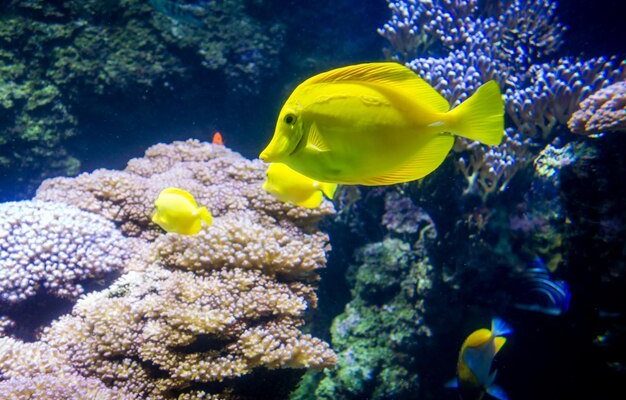
Imagine being on a vibrant coral reef; the water is warm, teeming with life, and every corner is a new adventure. That’s exactly where many species of tang fish thrive. From the dazzling Indo-Pacific to the bustling Caribbean, tangs are not just confined to one area but inhabit several diverse environments. Let’s explore where these remarkable fish hang out and what makes their homes so special.
The Oceans: A Tang’s Primary Habitat
Many tang fish are predominantly found in the ocean, particularly around coral reefs. These underwater structures are like bustling cities for marine life, providing shelter, food, and breeding grounds. Coral reefs offer a rich diversity of algae, which is a crucial part of the tang’s diet.
You might be wondering how these fish interact with their environment. Well, tangs play a vital role in maintaining the health of the reef. They help control algae growth, which ensures that coral can thrive. Without fish like the tang, we could end up with overgrown reefs that harm the entire ecosystem. So, when you think about tangs, remember they’re not just beautiful creatures; they’re essential for the health of their ocean homes!
Indo-Pacific Region
The Indo-Pacific region is arguably the most famous area for finding tang fish. This vast expanse includes warm waters from the eastern coast of Africa to the western shores of the Americas. Here, you’ll find species like the blue tang, known for its brilliant cerulean hue and iconic shape.
In this area, coral reefs offer ideal conditions for tang fish. The warm water temperature, abundant food supply, and complex structures provide the perfect environment for them to flourish. Imagine swimming through these waters, surrounded by a kaleidoscope of colorful fish and coral. That’s a tang’s everyday life!
Caribbean and Atlantic Waters
If you head over to the Caribbean, you’ll also encounter a range of tang fish species, including the doctorfish. These fish prefer the warmer waters and rich reefs found throughout the Caribbean islands.
In this region, tangs are often seen cruising around the coral formations, nibbling on algae and socializing with other reef inhabitants. The clear, blue waters make it easy for divers and snorkelers to spot them. The Caribbean is a charming paradise for tangs, filled with vibrant marine life and lush vegetation.
The Role of Habitats
Let’s take a moment to discuss habitats. Tang fish, like many marine creatures, rely heavily on their surroundings. They need areas with plenty of cover, such as rocks and corals, to hide from predators and reproduce. These habitats also provide the essential food sources tangs require, making them vital for their survival.
Maintaining healthy habitats is crucial for the continued existence of tang fish. Conservation efforts are underway in many regions to protect these delicate ecosystems. By keeping oceans clean and safeguarding coral reefs, we not only help tangs but a multitude of other marine species as well.
Rivers and Brackish Waters
While tang fish are primarily ocean dwellers, some species can be found in brackish waters, which are a mix of fresh and saltwater. These areas can be found where rivers meet the ocean, creating unique environments that certain tangs adapt to.
For example, the yellow tang, a popular aquarium fish, sometimes ventures into these brackish zones. These regions provide a different kind of habitat, with varying salinity levels, and can be a bit of a challenge for fish that usually prefer steady saltwater.
Being able to thrive in both marine and brackish environments showcases how adaptable tang fish are. It gives them a broader range of habitats to explore, find food, and reproduce.
Impact of Environmental Changes
With changing climates and increased pollution, the habitats of tang fish are under threat. Rising temperatures can lead to coral bleaching, which significantly affects where tangs can live and thrive. These environmental shifts can disrupt the entire food chain, showing just how interconnected marine life really is.
If you care about preserving tangs and their habitats, consider supporting conservation efforts. Protecting our oceans and rivers is crucial for ensuring that future generations can enjoy the beauty of these magnificent fish.
So, where are tang fish found? They inhabit vibrant coral reefs in oceans, especially in the Indo-Pacific and Caribbean, as well as some brackish waters where they show off their adaptability. These fish not only add color to our oceans but also play essential roles in maintaining the health of their ecosystems.
As we continue to learn more about these beautiful creatures, it’s vital to remember that their survival depends on the health of their habitats. We can all help by taking action to protect our oceans and reduce pollution. By doing this, we ensure that tang fish and countless other marine species have a bright future, swimming freely in the waters they call home.

